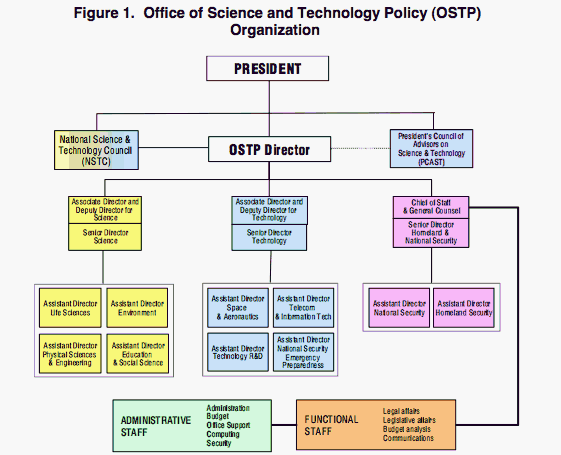Overview[]
Congress established the Office of Science and Technology Policy (OSTP) through the National Science and Technology Policy, Organization, and Priorities Act of 1976.[1] The Act states that
| “ | [t]he primary function of the OSTP Director is to provide, within the Executive Office of the President (EOP), advice on the scientific, engineering, and technological aspects of issues that require attention at the highest level of Government. [Further,] [t]he Office shall serve as a source of scientific and technological] analysis and judgment for the President with respect to major policies, plans, and programs of the Federal Government. | ” |
The OSTP Director manages the National Science and Technology Council (NSTC), established by Executive Order 12881, which coordinates science and technology (S&T) policy across the federal government, establishes national goals for federal S&T investments, and prepares coordinated research and development (R&D) strategies. In addition, the OSTP Director co-chairs the President's Council of Advisors on Science and Technology (PCAST), established by Executive Order 13226. The OSTP Director also plays a role in the communication of scientific and technical information by federal agency scientists and engineers.
The Director of the OSTP also chairs the JTRB, which brings together Federal communications policymakers with key authorities during an Incident of National Significance involving communications. The communications-related responsibilities and authorities for OSTP are found in the Communications Act of 1934, Executive Order 12472, ESF #2, and the NTSP.
The directors of the Office of Science and Technology Policy and OMB jointly release an annual memorandum to the heads of executive departments and agencies that specifies general R&D budget priorities. Agencies are encouraged to give these priorities full consideration when developing their budget requests, including those related to cyber security. In addition to general program guidance, the memorandums have made interagency R&D efforts (such as the federal NITRD program) a continuing priority.
The role and influence of OSTP, NSTC, PCAST, and its predecessor organizations have varied among Administrations, depending both on the President and the individual serving as OSTP Director. Unlike the heads of some other EOP agencies, the OSTP Director testifies before congressional committees, even though the office provides advice and assistance to the White House.
(Source: Office of Science and Technology Policy website.)
Major objectives[]
The OSTP summarizes its major objectives as follows:
- Advise the President and others within the Executive Office of the President on the impacts of science and technology on domestic and international affairs;
- Lead an interagency effort to develop and implement sound science and technology policies and budgets;
- Work with the private sector to ensure federal investments in science and technology contribute to economic prosperity, environmental quality, and national security;
- Build strong partnerships among federal, state, and local governments, other countries, and the scientific community; and
- Evaluate the scale, quality, and effectiveness of the Federal effort in science and technology.[2]
Publications[]
The following OSTP publications are discussed in this wiki:
- Designing a Digital Future: Federally Funded Research and Development in Networking and Information Technology (Jan. 17, 2013) (full-text); (Dec. 16, 2010) (full-text).
- Immediate Opportunities for Strengthening the Nation's Cybersecurity (Nov. 22, 2013) (full-text).
- Information Technology For The Twenty-First Century: A Bold Investment In America's Future (June 1999) (full-text).
- Letter Report on Education Technology (Dec. 2013) (full-text).
- Realizing the Full Potential of Government-Held Spectrum to Spur Economic Growth (July 20, 2012) (full-text).
- Realizing the Full Potential of Health Information Technology to Improve Healthcare for Americans: The Path Forward (Dec. 8, 2010) (full-text).
- Report to the President and Congress on the Fourth Assessment of the National Nanotechnology Initiative (Apr. 27, 2012) (full-text).
- Report to the President and Congress on the Third Assessment of the National Nanotechnology Initiative (Mar. 25, 2010) (full-text).
- Transformation and Opportunity: The Future of the U.S. Research Enterprise (Nov. 30, 2012) (full-text).
